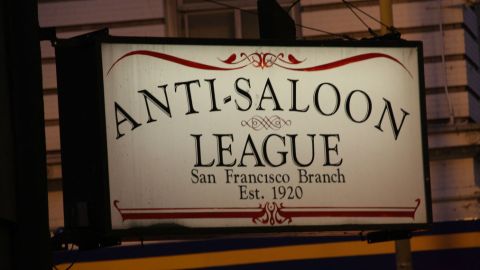Political Alliances – The KKK and the Anti-Saloon League

In today’s excerpt – the alliance between the church and the Ku Klux Klan that was crucial both to enacting Prohibition and the maintaining it for thirteen years.
Prohibition began in 1920 and lasted for thirteen years before it was repealed – primarily because of the tax revenues needed from alcohol sales as the Great Depression deepened. Prohibition did not spring forth overnight – in fact it took political activism over a period of almost eighty years to bring about Prohibition. Today’s commentators often lament what they see as the rise of “single-issue” or “narrow-issue” politics, whereby entire political movements are built around such issues as the environment, gay rights or social conservatism. However, single or narrow issue politics has been the rule rather than the exception in America since the very beginning. Perhaps the two greatest examples – the abolition of slavery and the prohibition of alcoholic beverages – both had their genesis in the 19th century. The organization most responsible for Prohibition (the “drys” as opposed to the “wets”) was the church-based Anti-Saloon League (ASL) and its legendary activist Wayne Wheeler. Wheeler was brilliant, indefatigable, and during his heyday, the most powerful man in American politics. Part of his effectiveness was his willingness to ally the ASL with any group that was willing to support Prohibition. For example, the ASL cooperated with the women’s suffrage movement because Wheeler knew women would vote for “dry” candidates. The ASL supported those in favor of the income tax, because Prohibition would have been impossible except for the introduction of an income tax – prior to Prohibition there was no income tax, and taxes on alcohol represented as much as 30 to 40% of national income. Most insidious, though, was the tacit alliance of the ASL with the Ku Klux Klan. Drinking was something that was most closely associated with blacks and immigrants such as the Irish and Italians (both largely Catholic). These were the very groups targeted by the Klan, and so the Klan was strongly pro-Prohibition:
“After the founder of the modern Klan, William J. Simmons, had been expelled from the secret order for chronic drunkenness (he spent his later years in an Atlanta movie house, smelling of bourbon and cloves, as he watched Birth of a Nation over and over), the next Imperial Wizard, a Dallas dentist named Hiram M. Evans, ushered in a new emphasis on the anti-Catholic and anti-Jewish parts of its program. This enabled the Klan to break out of the race-obsessed South and spread its influence across the map. The Klan of the 1920s ‘enrolled more members in Connecticut than in Mississippi, more in Oregon than in Louisiana, and more in New Jersey than in Alabama,’ wrote historian Stanley Coben. Over half a million Klansmen lived in Illinois, Indiana, and Ohio. Klan-backed candidates, all running on platforms both dry and xenophobic, were elected governor in Oregon, Colorado, and Kansas. In Detroit a Klan candidate whose name wasn’t even on the ballot was nearly elected mayor in an avalanche of write-in votes.
“Nativism (anti-immigrant activism) could find no better running mate than Prohibition. In many towns there was little distinction between membership in the Klan and in an ASL-affiliated church. At the national level the Anti-Saloon League did not overtly incite religious prejudice; Wheeler in fact worked to develop alliances with dry Catholics and Jews, and Ernest Cherrington made a conscious effort to keep the ASL’s public communications ecumenical. But to men like Roy Haynes, the Wheeler acolyte who headed the Prohibition Bureau, the Klan’s vigilant dryness was an exploitable asset.
“This became tragically clear in 1923 and 1924 when Williamson County, in southern Illinois, saw its law enforcement apparatus taken over by a vigilante army of between twelve and thirteen hundred Klansmen. Through the intervention of dry congressman Edward E. Denison, the Klansmen had been deputized by Haynes to clean up the county, which had been in the grip of bootleggers. The vigilantes were led by S. Glenn Young, who had earlier been drummed out of his position in the Prohibition Bureau as ‘a distinct and glaring disgrace . . . unfit to be in government service.’ After midnight on February 1, 1924, Young’s marauders raided the homes of immigrant Italian mineworkers, terrorizing women and children, and, if they found wine in the house, hauling their husbands and fathers off to jail. Rev. A. M. Stickney of the Marion Methodist Church provided ideological support, declaring that Catholics and Jews controlled America’s newspapers and insisting that only the Klan could protect America from disaster. Stickney also took pains to note that the assassins of Lincoln, Garfield, and McKinley had all been born Catholic.”





